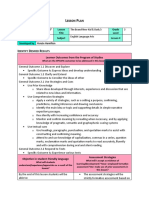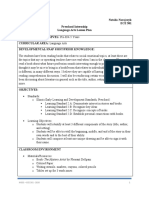Tutorial
Tutorial
Uploaded by
cruelnailerCopyright:
Available Formats
Tutorial
Tutorial
Uploaded by
cruelnailerCopyright
Available Formats
Share this document
Did you find this document useful?
Is this content inappropriate?
Copyright:
Available Formats
Tutorial
Tutorial
Uploaded by
cruelnailerCopyright:
Available Formats
Tutorial Plan: ‘Boy: Tales of Childhood’ by Roald Dahl
Subject English/Literacy
Year Level Year 8 Mixed ability cohort
Learning sequence 3x50 minute tutorials
Outcomes ● makes effective language choices to creatively shape meaning
with accuracy, clarity and coherence
● thinks imaginatively, creatively, interpretively and critically about
information, ideas and arguments to respond to and compose
texts
● identifies and explains connections between and among texts
● uses, reflects on and assesses their individual and collaborative
skills for learning
Aims of the Read for Enjoyment: I will share with the pupils the books, videos
tutorial similar or based on our focus text ‘Boy”. This will broaden their
interest on more creative work.
Overview This session looks at a popular book ‘Boy’ by Roald Dahl which is
appropriate for the age level. The students should learn mostly by
participation during study/tutorial time and engage in reading outside
of class time.
Focus Skills: Improve students’ comprehension and creative and critical thinking
skills through reading, writing and discussions.
Shared and Create opportunities for students to read, reflect, write independently
Independent work and as a group. Also, create opportunities for class and small group
discussions, unpacking the story for understanding. Opportunities for
predicting, questioning, making connections etc.
Assignment Design a travel brochure for Dahl enthusiasts. This is to take them to
all the major destinations in Boy, its sequel Going Solo, and any other
places you think appropriate – perhaps some of the places (real or
fictional) mentioned in his other books. Provide a full list of activities
for your travellers to do on their trip.
Learning To create interest in each student to engage them with reading
intentions similar or variety of genres and improve comprehension skills. Also,
to explore their own creativity to express personal experiences in
written form.
Success Criteria All students will complete reading the text, participate in small group
discussions, take notes.
Most students will complete reading the text independently, participate
in class and small group discussions, complete all written tasks.
Some actively and independently participate in all reading, speaking
and writing activities, questioning and using sophisticated vocabulary.
Also complete all the extension task.
Teaching and Before During
Learning
Opportunities Prep session: I Model Explicitly teach how to apply the particular
will conduct for a comprehension skill (predicting, monitoring,
preparatory summarising, making connections, visualsing,
tutorial session questioning)
one week before
the real tutorial so Unpack any unfamiliar words throughout the
as to make the unit.
whole class take
interest in reading Encourage students to use sophisticated
the text ‘Boy’ and vocabulary in their written responses.
to come prepared.
I will distribute
illustrations of the I will guide the students through reading the text,
cover and from motivating and bringing their attention to the
the text of the illustrations. How pictures tell the story.
book to refer to Encourage students find similar instances in
them in the actual their own lives (making connections). I will
tutorial. encourage them to learn through practice of new
skills. Students will be encouraged to do
Pre-Reading activities independently as well as collectively in
Stage-in which to small groups. I will observe their learning,
familiarise provide feedback to facilitate their progress. I will
students with the mostly carry out the tutorial by learning through
text and “real life” situations rather than theoretically.
illustrations
appearing in the Whole Class:
book and provoke 1. First draw the attention of all students to pay
their thinking. attention and participate in understanding the
book, ‘Boy’ by Roald Dahl. Discuss concept of
Introduce the Biography, autobiography, coming of age story
tutorial subject concepts by eliciting responses from pupils.
and it’s aim. 2. Ask the whole class what the book is about? If
they had similar experiences as the author
has described in the book.
Now the class is to be divided into four
groups
Group Work:
1. Ask group 1 to come to the front. Their job is
to take notes and discuss the story among
themselves and come up with ideas of
biography and autobiography.
2. Group 2 will take notes and discuss and
present characters which they found
interesting.
3. Group 3 will take notes and speak about the
places described in the book such as Wales,
Norway.
4. Group 4 will take notes and speak about the
school scene. They should try to highlight
things in the author’s life as a student that
they liked or disliked.
In all the groups one pupil will do the job of a
scribe and write down new words or ideas. I will
support scribing for the students with lower ability.
Whole Class:
Following the group work, the class will merge
and the students will be asked to write 10 to 15
lines on the content of the book in their own
words.
Assessment Teacher observation, student written and oral responses.
Differentiation Tutorial for pupils of low or special abilities:
I will
● Create their interest in stories by playing some of the videos based
on writing by Roald Dahl for children, namely The Witches, Willy
Wonka and the Chocolate Factory, Matilda which is also a musical.
The themes of these videos are similar to what Dahl writes in
“Boy” and hence relate to the pupil well.
● have them read the text aloud and pay special attention to the
ones who are slow in uninterested in the reading. I will also resort
to re-reading for the pupils to gain fluency and smoothness. This
repeated reading will help slow learners decode the word
meanings better.
● encourage talk with me and their peers to develop more interest in
the activity. This "verbal processing" helps them remember and
think through the themes of the book. I will ask questions before,
during, and after the session to encourage reading
comprehension. The questions will be on names of characters,
location, why something happened, did any similar happen to the
pupils themselves etc.
● use context clues. Using context clues will help pupils understand
what they are reading even if they don’t know all the vocabulary
being used.
● ask them to write summary of the text they read.
● eliminate distractions as much as possible
● encouraging students with lower or special ability to read e-books
or audiobooks to develop their reading skills. Also use talk-to- text
to support their note taking.
Resources: ‘Boy’ by Roald Dahl - hard copy, e-Book, audio book
Vidos
PPP
Images
Evaluation
You might also like
- The Strategies in Teaching Literacy Through LiteratureDocument5 pagesThe Strategies in Teaching Literacy Through LiteratureRamelin100% (6)
- Unit 1 Empower B1+ PDFDocument13 pagesUnit 1 Empower B1+ PDFDominika100% (1)
- Lesson Plan 1: Discussion On The Final Chapter (Synchronous)Document15 pagesLesson Plan 1: Discussion On The Final Chapter (Synchronous)api-530707431No ratings yet
- Advancing 5e 04Document19 pagesAdvancing 5e 04api-261615090100% (2)
- Common Core Lesson PlannerDocument3 pagesCommon Core Lesson Plannerapi-419135285No ratings yet
- CT Observation Lesson PlanDocument3 pagesCT Observation Lesson Planapi-400377867No ratings yet
- Cam Hamilton Lesson Plan Portfolio Cross-Curricular With Social Studies and Visual ArtDocument18 pagesCam Hamilton Lesson Plan Portfolio Cross-Curricular With Social Studies and Visual ArtMarshall GorgonzolaNo ratings yet
- Secondary Curriculum 1B - Standard 3.2, 3.3, 3.4Document5 pagesSecondary Curriculum 1B - Standard 3.2, 3.3, 3.4Yvette Kristine RamosNo ratings yet
- English Unit PlanDocument6 pagesEnglish Unit Planapi-469895619No ratings yet
- English Lesson Plan 2Document4 pagesEnglish Lesson Plan 2api-518990010No ratings yet
- Lesson Plan Template Grade/Content Area Lesson Title State StandardsDocument4 pagesLesson Plan Template Grade/Content Area Lesson Title State Standardsapi-404244796No ratings yet
- Khaitmatova CriteriaDocument5 pagesKhaitmatova CriteriaМадина ХайтматоваNo ratings yet
- CTE 7040 - Jessica Pudlio Cultural Lesson PlanDocument3 pagesCTE 7040 - Jessica Pudlio Cultural Lesson PlanJessica PulidoNo ratings yet
- Inquiry Lesson PlanDocument3 pagesInquiry Lesson Planapi-346526495No ratings yet
- How To Use The Learners As A ResourceDocument7 pagesHow To Use The Learners As A ResourceJosé Manuel Henríquez GalánNo ratings yet
- Day To DayDocument9 pagesDay To Dayapi-359979131No ratings yet
- Activating Comprehension: Non-Fiction in The Classroom: Teaching Children To Read, Good Readers AreDocument4 pagesActivating Comprehension: Non-Fiction in The Classroom: Teaching Children To Read, Good Readers AreAnthony KrippesNo ratings yet
- Liberty Bell Lesson PlanDocument3 pagesLiberty Bell Lesson Planapi-346526495No ratings yet
- Lesson Plan English Sekolah Amanah 1Document4 pagesLesson Plan English Sekolah Amanah 1Yunus RazaliNo ratings yet
- Lesson Plan SEL FocusDocument3 pagesLesson Plan SEL Focusineveen4No ratings yet
- Spring Shellsea Melaratep Elementary Lesson Plan Abridged Original 1 1Document5 pagesSpring Shellsea Melaratep Elementary Lesson Plan Abridged Original 1 1api-667812603No ratings yet
- Teaching-Guide-Catchup-READING GRADE 8 q4w6Document1 pageTeaching-Guide-Catchup-READING GRADE 8 q4w6gabatonelbsed3No ratings yet
- CLR Read Aloud Lesson Plan Template 1 1 2Document3 pagesCLR Read Aloud Lesson Plan Template 1 1 2api-744634324No ratings yet
- Lesson Plan 1 Final oDocument4 pagesLesson Plan 1 Final oapi-654894192No ratings yet
- Lesson Plan 1Document4 pagesLesson Plan 1api-296414448No ratings yet
- Readers Notebook Literacy Acitivties PlannerDocument4 pagesReaders Notebook Literacy Acitivties Plannerapi-363254905No ratings yet
- Lesson Plan BasicsDocument21 pagesLesson Plan BasicsFroilan TinduganNo ratings yet
- Teaching-Guide-Catchup-READING GRADE 8aprDocument2 pagesTeaching-Guide-Catchup-READING GRADE 8aprgabatonelbsed3No ratings yet
- The Three Little Pigs - Ela-Literacy Lesson PlanDocument4 pagesThe Three Little Pigs - Ela-Literacy Lesson Planapi-642378584No ratings yet
- Perdev-Dlp Lesson 1 Knowing OneselfDocument5 pagesPerdev-Dlp Lesson 1 Knowing Oneselfkarla joy 05No ratings yet
- Autobiography Writing PlanDocument3 pagesAutobiography Writing PlanRasha SaadNo ratings yet
- August 2 DLP - DictionDocument5 pagesAugust 2 DLP - DictionehldeponeNo ratings yet
- Ed615 Lesson He Lion Bruh Bear and Bruh RabbitDocument10 pagesEd615 Lesson He Lion Bruh Bear and Bruh Rabbitapi-394394249No ratings yet
- Ela Monday November 8th LessonDocument5 pagesEla Monday November 8th Lessonapi-590146884No ratings yet
- Language Arts Lesson PlanDocument4 pagesLanguage Arts Lesson Planapi-553063110No ratings yet
- Dylan Thomas Short Stories Lesson PlanDocument3 pagesDylan Thomas Short Stories Lesson Planteachermario.online23No ratings yet
- Lesson 1 - Guided ReadingDocument4 pagesLesson 1 - Guided Readingapi-509036585No ratings yet
- Edsc 440s Lesson Plan DraftDocument5 pagesEdsc 440s Lesson Plan Draftapi-431015136No ratings yet
- Sheila Rae Lesson Revised PDFDocument5 pagesSheila Rae Lesson Revised PDFapi-453830123No ratings yet
- Brown Rice - Summative Video AnalysisDocument11 pagesBrown Rice - Summative Video Analysisapi-325020668No ratings yet
- Lesson 11 ELADocument2 pagesLesson 11 ELAotumanyanNo ratings yet
- Lesson 11 ELADocument2 pagesLesson 11 ELAotumanyanNo ratings yet
- Function Notion Topic and Situation 1Document33 pagesFunction Notion Topic and Situation 1ayas67240No ratings yet
- Lesson 3Document4 pagesLesson 3api-428818739No ratings yet
- Short Story Lesson PlanDocument4 pagesShort Story Lesson Planapi-372387144No ratings yet
- Lesson PlanDocument7 pagesLesson Planapi-651343326No ratings yet
- Integrated Skills Lesson PlanDocument3 pagesIntegrated Skills Lesson PlanNatasha Tan100% (1)
- Unit ContentsDocument13 pagesUnit Contentsрарп раоиNo ratings yet
- Lesson Script For Grade 4 Quarter 1 Week 1 Catch Up Friday (ROV)Document14 pagesLesson Script For Grade 4 Quarter 1 Week 1 Catch Up Friday (ROV)Patrick Matibag88% (8)
- English Lesson PlanDocument4 pagesEnglish Lesson Planapi-518990010No ratings yet
- Content 15 SEMI FINALS REVIEWERDocument4 pagesContent 15 SEMI FINALS REVIEWERYuno GrinberryallNo ratings yet
- Weekly Scheme of Learning-Week 8: 10 MinsDocument7 pagesWeekly Scheme of Learning-Week 8: 10 MinsJames NUGBANo ratings yet
- Neral Principles in Teaching Literacy in The ElementaryDocument18 pagesNeral Principles in Teaching Literacy in The ElementaryKai SubidoNo ratings yet
- Practicum PlanDocument15 pagesPracticum Planapi-525507350No ratings yet
- Lena Archer Jarred Wenzel Curriculum Ideology AssignmentDocument9 pagesLena Archer Jarred Wenzel Curriculum Ideology Assignmentapi-482428947No ratings yet
- Minor JDocument6 pagesMinor Japi-341972597No ratings yet
- Observed LessonsDocument17 pagesObserved Lessonsapi-474721095No ratings yet
- Lesson Plan: General Learning Outcome(s)Document6 pagesLesson Plan: General Learning Outcome(s)api-526388634No ratings yet
- Arooj A-Fuzz Frenzy Pop Cycle 1 Lesson PlanDocument3 pagesArooj A-Fuzz Frenzy Pop Cycle 1 Lesson Planapi-698849093No ratings yet
- Lesson Plan Template LTM-612 CommentsDocument5 pagesLesson Plan Template LTM-612 Commentsapi-385649852No ratings yet
- The Literature Toolbox: Practical Strategies for Exploring TextsFrom EverandThe Literature Toolbox: Practical Strategies for Exploring TextsNo ratings yet
- Sunrise 12: (English SoundDocument11 pagesSunrise 12: (English SoundRêber MohammedNo ratings yet
- Semiotic Analysis - AbstractDocument40 pagesSemiotic Analysis - Abstractmonata80100% (1)
- Waldemar Gutwinski - Cohesion in Literary TextsDocument188 pagesWaldemar Gutwinski - Cohesion in Literary Textsh0ry100% (1)
- Learning-Activity-Sheet Week 3 (Oral Com)Document13 pagesLearning-Activity-Sheet Week 3 (Oral Com)Ryzabeth Silagan BardoquilloNo ratings yet
- The Correlation Between Students Grammar Knowledge and Their Speaking Ability JournalDocument7 pagesThe Correlation Between Students Grammar Knowledge and Their Speaking Ability JournalDian Islamiati100% (1)
- Cambridge IGCSE ™: Spanish 0530/22Document11 pagesCambridge IGCSE ™: Spanish 0530/22Zenia GonzalezNo ratings yet
- Types of Speech StyleDocument13 pagesTypes of Speech StyleJovenilda FiguerresNo ratings yet
- C10 Ois-Ss English LanguageDocument22 pagesC10 Ois-Ss English LanguageJohn DoeNo ratings yet
- Advertising Cover LetterDocument4 pagesAdvertising Cover Letterafiwjsazh100% (2)
- 10WAYS To Teach GrammarDocument1 page10WAYS To Teach GrammarmahmoudabusamraNo ratings yet
- RRL For WritingDocument27 pagesRRL For Writingirene tumbagahanNo ratings yet
- Trialability and Purposefulness Their Ro SAMPLE To FOLLOWDocument20 pagesTrialability and Purposefulness Their Ro SAMPLE To FOLLOWmarcjasonongNo ratings yet
- Checklist For Revising, Editing & Peer-Critiquing 1 Draft of Research EssayDocument2 pagesChecklist For Revising, Editing & Peer-Critiquing 1 Draft of Research EssayMarvin McLeodNo ratings yet
- Teaching Methods 2Document8 pagesTeaching Methods 2miguelroschelleNo ratings yet
- Titus Tanko'S Copy GNS 401: Communication in English IvDocument14 pagesTitus Tanko'S Copy GNS 401: Communication in English IvTitus TankoNo ratings yet
- Presentation Rubrics For The Intermediate LevelDocument1 pagePresentation Rubrics For The Intermediate LevelHala Khaled ArarNo ratings yet
- Describe The PresentationDocument3 pagesDescribe The PresentationskyNo ratings yet
- Primus Featural Analysis 2004 PDFDocument40 pagesPrimus Featural Analysis 2004 PDFDMD_GannonNo ratings yet
- ASL II Syllabus (FA21)Document9 pagesASL II Syllabus (FA21)Matt AndersenNo ratings yet
- APA Referencing GuideDocument4 pagesAPA Referencing Guideakshayah.varshaNo ratings yet
- Theme Unit Analysis A Systemic Functional Treatment of Textual Meanings in JapaneseDocument30 pagesTheme Unit Analysis A Systemic Functional Treatment of Textual Meanings in JapaneseLeigh Yohei BennettNo ratings yet
- PKBK3073 English Teaching Methodology For Pupils With Learning DificulttiesDocument6 pagesPKBK3073 English Teaching Methodology For Pupils With Learning Dificulttiesnik nur hanisNo ratings yet
- Component 1 As English Language Annotated Examples 2022Document24 pagesComponent 1 As English Language Annotated Examples 2022Anvita NazarethNo ratings yet
- Pengaruh Bahasa Ibunda Dalam Proses Pembelajaran Bahasa Melayu MuridDocument19 pagesPengaruh Bahasa Ibunda Dalam Proses Pembelajaran Bahasa Melayu Muridcivic109No ratings yet
- Tarea 4 Unit 6 Finding / Applying For A JobDocument8 pagesTarea 4 Unit 6 Finding / Applying For A JobBetsi PerezNo ratings yet
- Municating in EnglishDocument344 pagesMunicating in EnglishKunthida KtNo ratings yet
- Eng1103 Group WorkDocument3 pagesEng1103 Group WorkamrhkmhNo ratings yet
- Collocations: Fast Foodthe Quick Train A Quick Meala Fast ShowerDocument3 pagesCollocations: Fast Foodthe Quick Train A Quick Meala Fast ShowerSaravana SelvakumarNo ratings yet
- DLL - English 4 - Q2 - W5Document4 pagesDLL - English 4 - Q2 - W5Nerissa MendezNo ratings yet

























































































